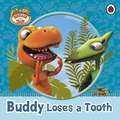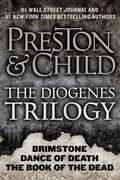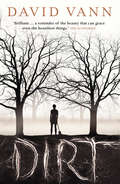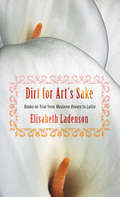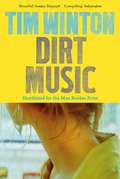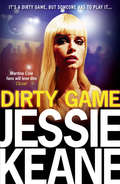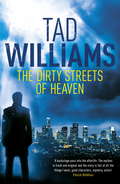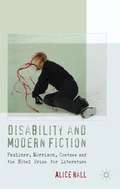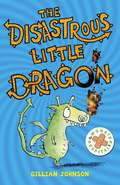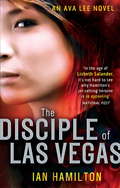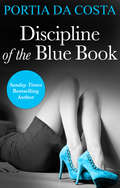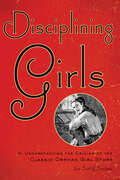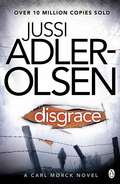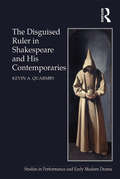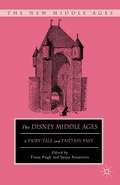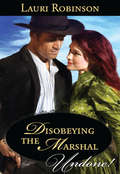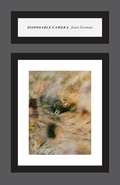- Table View
- List View
Dinosaur Train: Buddy Loses a Tooth (Dinosaur Train)
by Jim HensonToot toot! All aboard the Dinosaur Train! In this storybook, Buddy loses his first tooth. But his whole family is confused because Pteranodons don't lose teeth. So Buddy heads to Rexville station to find out why T. rexes lose their teeth. ROAR!Dinosaur Train is a brand new animated series for children aged 3-6, airing on Nick Jr. The television show follows Buddy, a curious T. rex, and his adopted family, the Pterandons, as they meet new dinosaurs and explore the world around them. The dinosaur train travels through the Triassic, Jurassic and Cretaceous worlds, and each episode is packed with amazing prehistoric creatures! Look out for other titles in the Ladybird storybook series: The Spooky Scavenger Hunt, A Surprise for Mum and I Am a T. rex!
The Diogenes Trilogy: Brimstone, Dance of Death, and The Book of the Dead Omnibus (Agent Pendergast series)
by Douglas Preston Lincoln ChildNow, available for the first time together in a single volume: a digital-only, value-priced omnibus edition of the "Diogenes Trilogy": Brimstone, Dance of Death, and The Book of the Dead--featuring Pendergast's mysterious brother--by #1 New York Times bestselling authors Preston & Child. BRIMSTONE:A body is found in the attic of a fabulous Long Island estate. There is a hoofprint scorched into the floor, and the stench of sulfur chokes the air. When FBI Special Agent Pendergast investigates the gruesome crime, he discovers that thirty years ago four men conjured something unspeakable. Has the devil come to claim his due?DANCE OF DEATH:Two brothers. One, top FBI Agent, Aloysius Pendergast. The other, Diogenes, a brilliant and twisted criminal. An undying hatred between them. Now, a perfect crime. And the ultimate challenge: Stop me if you can.BOOK OF THE DEAD:A talented FBI agent, rotting away in a high security prison for a murder he did not commit. His psychotic brother, about to perpetrate a horrific crime. A young woman with an extraordinary past, on the edge of a violent breakdown. An ancient Egyptian tomb about to be unveiled at a celebrity-studded New York gala, an enigmatic curse released. Memento Mori.
Dip in the Pool (A Roald Dahl Short Story)
by Roald DahlDip in the Pool is a short, sharp story from Roald Dahl, the master of the shocking tale.In Dip in the Pool, Roald Dahl, one of the world's favourite authors, tells an unsettling story of human folly. Here, a man acts rashly and life-threateningly to ensure he wins a prize . . .Dip in the Pool is taken from the short story collection Someone Like You, which includes seventeen other devious and shocking stories, featuring the wife who serves a dish that baffles the police; a curious machine that reveals the horrifying truth about plants; the man waiting to be bitten by the venomous snake asleep on his stomach; and others.'The absolute master of the twist in the tale.' (Observer ) This story is also available as a Penguin digital audio download read by Adrian Scarborough.Roald Dahl, the brilliant and worldwide acclaimed author of Charlie and the Chocolate Factory, James and the Giant Peach, Matilda, and many more classics for children, also wrote scores of short stories for adults. These delightfully disturbing tales have often been filmed and were most recently the inspiration for the West End play, Roald Dahl's Twisted Tales by Jeremy Dyson. Roald Dahl's stories continue to make readers shiver today.
Dirt
by David VannTwenty-two-year-old Galen is a New Age believer on a warpath towards transcendence. He lives with his emotionally dependent mother in a secluded house, surviving on old family money that his Aunt Helen and cousin Jennifer are determined to get their hands on. Galen doesn’t know who his father is, his abusive grandfather is dead, and his grandmother is losing her memory. When the family takes a trip to an old cabin in the Sierras, tensions crescendo. Caught in a compromising position, Galen will discover the shocking truth of just how far he will go to attain what it is he craves.
Dirt for Art's Sake: Books on Trial from "Madame Bovary" to "Lolita"
by Elisabeth LadensonIn Dirt for Art's Sake, Elisabeth Ladenson recounts the most visible of modern obscenity trials involving scandalous books and their authors. What, she asks, do these often-colorful legal histories have to tell us about the works themselves and about a changing cultural climate that first treated them as filth and later celebrated them as masterpieces? Ladenson's narrative starts with Madame Bovary (Flaubert was tried in France in 1857) and finishes with Fanny Hill (written in the eighteenth century, put on trial in the United States in 1966); she considers, along the way, Les Fleurs du Mal, Ulysses, The Well of Loneliness, Lady Chatterley's Lover, Tropic of Cancer, Lolita, and the works of the Marquis de Sade.Over the course of roughly a century, Ladenson finds, two ideas that had been circulating in the form of avant-garde heresy gradually became accepted as truisms, and eventually as grounds for legal defense. The first is captured in the formula ?art for art's sake??the notion that a work of art exists in a realm independent of conventional morality. The second is realism, vilified by its critics as ?dirt for dirt's sake.? In Ladenson's view, the truth of the matter is closer to ?dirt for art's sake??the idea that the work of art may legitimately include the representation of all aspects of life, including the unpleasant and the sordid. Ladenson also considers cinematic adaptations of these novels, among them Vincente Minnelli's Madame Bovary, Stanley Kubrick's Lolita and the 1997 remake directed by Adrian Lyne, and various attempts to translate de Sade's works and life into film, which faced similar censorship travails. Written with a keen awareness of ongoing debates about free speech, Dirt for Art's Sake traces the legal and social acceptance of controversial works with critical acumen and delightful wit.
Dirt Music (Picador 40th Anniversary Editions Ser.)
by Tim WintonSHORTLISTED FOR THE BOOKER PRIZE'Compelling' Independent'Beautiful' Sunday Telegraph Georgie Jutland is a mess. At forty, with her career in ruins, she finds herself stranded with a man she doesn't love and two kids whose dead mother she can never replace. She spends her days in isolated tedium and her nights in a blur of vodka and self-recrimination. Until, early one morning, she sees a shadow drifting up the beach below her house. It is Luther Fox, an outcast, a man on the run from his own past. And now here he is stepping into Georgie’s life. He brings hope, maybe even love, but also danger . . .Dirt Music by Tim Winton is a novel about the power of love.
Dirty Deeds (The Mudcrusts)
by Damian HarveyMeet the Mudcrusts! LowbrowMudcrust is the lumbering, lazy head of the family, who is happiestwhen he is squelching his toes in the slime. That doesn't stop his wifeFlora from nagging him and reminding him that he's not the chief of thetribe. Their two children, Bogweed and Fungus, are always fighting.Although Fungus doesn't have Bogweed's brute strength, he is does havemore brains.The first book in the Mudcrusts series, Dirty Deeds follows the quest of Flora to move out of their hut into a nice cave with a view...
Dirty Game
by Jessie KeaneAdultery, murder and dangerous love collide in Jessie Keane’s gritty debut novel.
Dirty Little Secret: Dead Spy Running, Games Traitors Play, Dirty Little Secret (A\daniel Marchant Thriller Ser. #3)
by Jon StockFor fans of Bond and Bourne, the third instalment of the pulse-pounding Daniel Marchant spy series.
The Dirty Streets of Heaven: Bobby Dollar 1 (Bobby Dollar #1)
by Tad WilliamsBOBBY DOLLAR ISN'T YOUR AVERAGE ANGEL.Sure, he takes the occasional trip to Heaven, but his job as an advocate - arguing the fate of the recently deceased - keeps him pretty busy on Earth, and he's more than happy to spend the rest of his time propping up the bar with his fellow immortals.Until the day a soul goes missing, presumed stolen by 'the other side'.A new chapter in the war between heaven and hell is about to open. And Bobby is right in the middle of it, with only a desirable but deadly demon to aid him.
Disability And Modern Fiction: Faulkner, Morrison, Coetzee And The Nobel Prize For Literature (PDF)
by Alice HallFocusing on Faulkner, Morrison and Coetzee as authors, critics and Nobel Prize-winning intellectuals, this book explores shifting representations of disability in 20th and 21st century literature and proposes new ways of reading their works in relation to one another, whilst highlighting the ethical, aesthetic and imaginative challenges they pose.
Disability And Modern Fiction: Faulkner, Morrison, Coetzee And The Nobel Prize For Literature
by Alice HallFocusing on Faulkner, Morrison and Coetzee as authors, critics and Nobel Prize-winning intellectuals, this book explores shifting representations of disability in 20th and 21st century literature and proposes new ways of reading their works in relation to one another, whilst highlighting the ethical, aesthetic and imaginative challenges they pose.
Disability and Modern Fiction: Faulkner, Morrison, Coetzee and the Nobel Prize for Literature
by A. HallFocusing on Faulkner, Morrison and Coetzee as authors, critics and Nobel Prize-winning intellectuals, this book explores shifting representations of disability in 20th and 21st century literature and proposes new ways of reading their works in relation to one another, whilst highlighting the ethical, aesthetic and imaginative challenges they pose.
The Disastrous Little Dragon: Book 2 (Monster Hospital #2)
by Gillian JohnsonBartholomew the dragon is brought to Monster Hospital by his fierce aunty Madge. He's got a terrible case of smoke inhalation because he can't breathe fire -- and he can't fly either! Can four naughty children - Sylvie, Dylan, Carolyn and Tom - help him, without getting cooked to a crisp by terrifying Aunty Madge? Maybe they can, if there's a princess involved...This book follows the first Monster Hospital adventure: THE BIG, FAT, SMELLY OGRE and is written and illustrated by the acclaimed author illustrator of the THORA books.
The Disciple of Las Vegas: 2 (Ava Lee #2)
by Ian HamiltonUncompromising. Tenacious. Fiercely intelligent. Ava Lee will follow the money . . . wherever it takes her.Hired by Tommy Ordonez, the richest man in the Philippines, to recover $50 million in a land swindle, Ava has her work cut out. Tommy's brother has messed up and the Filipino billionaire's reputation is on the line.Tracking the money, Ava uncovers an illegal online gambling ring, and follows the trail to Las Vegas. Once there, she turns her gaze to David Douglas, one of the greatest poker players in the world - and someone who knows more about the missing money than he's letting on. Meanwhile, Jackie Leung, an old target of Ava's, has made it rich. He wants revenge, and he's going after Ava.
Discipline of the Blue Book (3 Colors Sexy #1)
by Portia Da CostaI can't stop looking at it. This book I found tucked at the back of the bookshelf in our holiday cottage. I'm reading the Blue Book, or more accurately, looking at its pictures again and again. It must be based on some real need. Some real kink. Somebody must have wanted it. I think I do…
Disciplining Girls: Understanding the Origins of the Classic Orphan Girl Story
by Joe Sutliff SandersAt the heart of some of the most beloved children’s novels is a passionate discussion about discipline, love, and the changing role of girls in the twentieth century. Joe Sutliff Sanders traces this debate as it began in the sentimental tales of the mid-nineteenth century and continued in the classic orphan girl novels of Louisa May Alcott, Frances Hodgson Burnett, L. M. Montgomery, and other writers still popular today. Domestic novels published between 1850 and 1880 argued that a discipline that emphasized love was the most effective and moral form. These were the first best sellers in American fiction, and by reimagining discipline as a technique of the heart—rather than of the whip—they ensured their protagonists a secure, if limited, claim on power. This same ideal was adapted by women authors in the early twentieth century, who transformed the sentimental motifs of domestic novels into the orphan girl story made popular in such novels as Anne of Green Gables and Pollyanna. Through close readings of nine of the most influential orphan girl novels, Sanders provides a seamless historical narrative of American children’s literature and gender from 1850 until 1923. He follows his insightful literary analysis with chapters on sympathy and motherhood, two themes central to both American and children’s literature, and concludes with a discussion of contemporary ideas about discipline, abuse, and gender. Disciplining Girls writes an important chapter in the history of American, women’s, and children’s literature, enriching previous work about the history of discipline in America.
Disgrace (Department Q #2)
by Jussi Adler-OlsenA closed case that hides a terrible secret. Read a dark and gripping thriller in the 16-million-copy bestselling Department Q series, for a special price - perfect for readers of Jo Nesbo . . . Detective Carl Mørck of Department Q, the cold cases division, has received a file concerning the brutal murder of a brother and sister twenty years earlier. The killer was quickly found - so why is the file of a closed case on Carl's desk? Who put it there? Who believes the case is not solved?Carl wants to talk to Kimmie, a homeless woman who seems to hold the key to the mystery. But he's not the only one asking questions about her. Someone knows Kimmie carries secrets certain powerful people want to stay buried deep. But little do they realise, Kimmie has a secret all of her own...Praise for Jussi Adler-Olsen'The new "it" boy of Nordic Noir' The Times 'Gripping story-telling' Guardian'Mesmerising... As impressive as it is unnerving' Independent'Engrossing' Sunday Express
The Disguised Ruler in Shakespeare and his Contemporaries (Studies in Performance and Early Modern Drama)
by Kevin A. QuarmbyIn the early seventeenth century, the London stage often portrayed a ruler covertly spying on his subjects. Traditionally deemed 'Jacobean disguised ruler plays', these works include Shakespeare's Measure for Measure, Marston's The Malcontent and The Fawn, Middleton's The Phoenix, and Sharpham's The Fleer. Commonly dated to the arrival of James I, these plays are typically viewed as synchronic commentaries on the Jacobean regime. Kevin A. Quarmby demonstrates that the disguised ruler motif actually evolved in the 1580s. It emerged from medieval folklore and balladry, Tudor Chronicle history and European tragicomedy. Familiar on the Elizabethan stage, these incognito rulers initially offered light-hearted, romantic entertainment, only to suffer a sinister transformation as England awaited its ageing queen's demise. The disguised royal had become a dangerously voyeuristic political entity by the time James assumed the throne. Traditional critical perspectives also disregard contemporary theatrical competition. Market demands shaped the repertories. Rivalry among playing companies guaranteed the motif's ongoing vitality. The disguised ruler's presence in a play reassured audiences; it also facilitated a subversive exploration of contemporary social and political issues. Gradually, the disguised ruler's dramatic currency faded, but the figure remained vibrant as an object of parody until the playhouses closed in the 1640s.
The Disguised Ruler in Shakespeare and his Contemporaries (Studies in Performance and Early Modern Drama)
by Kevin A. QuarmbyIn the early seventeenth century, the London stage often portrayed a ruler covertly spying on his subjects. Traditionally deemed 'Jacobean disguised ruler plays', these works include Shakespeare's Measure for Measure, Marston's The Malcontent and The Fawn, Middleton's The Phoenix, and Sharpham's The Fleer. Commonly dated to the arrival of James I, these plays are typically viewed as synchronic commentaries on the Jacobean regime. Kevin A. Quarmby demonstrates that the disguised ruler motif actually evolved in the 1580s. It emerged from medieval folklore and balladry, Tudor Chronicle history and European tragicomedy. Familiar on the Elizabethan stage, these incognito rulers initially offered light-hearted, romantic entertainment, only to suffer a sinister transformation as England awaited its ageing queen's demise. The disguised royal had become a dangerously voyeuristic political entity by the time James assumed the throne. Traditional critical perspectives also disregard contemporary theatrical competition. Market demands shaped the repertories. Rivalry among playing companies guaranteed the motif's ongoing vitality. The disguised ruler's presence in a play reassured audiences; it also facilitated a subversive exploration of contemporary social and political issues. Gradually, the disguised ruler's dramatic currency faded, but the figure remained vibrant as an object of parody until the playhouses closed in the 1640s.
The Disney Middle Ages: A Fairy-Tale and Fantasy Past (The New Middle Ages)
by Tison Pugh and Susan AronsteinFor many, the middle ages depicted in Walt Disney movies have come to figure as the middle ages, forming the earliest visions of the medieval past for much of the contemporary Western (and increasingly Eastern) imagination. The essayists of The Disney Middle Ages explore Disney's mediation and re-creation of a fairy-tale and fantasy past, not to lament its exploitation of the middle ages for corporate ends, but to examine how and why these medieval visions prove so readily adaptable to themed entertainments many centuries after their creation. What results is a scrupulous and comprehensive examination of the intersection between the products of the Disney Corporation and popular culture's fascination with the middle ages.
Disobeying the Marshal (Mills And Boon Historical Undone Ser.)
by Lauri RobinsonEl Dorado, Kansas, 1881 Marshal Cord Donovan believed he was married to his badge—until one incredible night in Florie Rockford's bed changed everything. When Florie unexpectedly arrives in town with a desperate warning for his safety, Cord is determined to show her that their spark burns so hot that one night will never be enough.
Displaced Persons (Simon Kenworthy #16)
by John Buxton Hilton‘They know her as Jacqueline Fernet—and she’s in trouble. And the Examining Magistrate has apparently unearthed a connection with British Wartime Intelligence. Your name has cropped up, and he’d like to talk to you about it.’ Retired Superintendent Kenworthy would never have recognized his wartime acquaintance Marie-Thérèse in the ageing woman found near a murdered man with three-quarters of a million francs in her possession. But he could identify the man. He had been Kenworthy’s superior officer in an advance detachment of British troops during the 1944 thrust through the Low Countries. Marie-Thérèse had been something of a camp-follower and mascot, and Kenworthy learned that other wartime associates had kept in touch with her. Why? Was it blackmail? Marie-Thérèse had been suspected of it before. But who directed her? And who was their victim?
Disposable Camera (Phoenix Poets)
by Janet FoxmanAlthough Disposable Camera is Janet Foxman’s first book-length collection, one would not know it given the wry sophistication of the poems found within. The notion of the disposable camera permeates the entire book, where Foxman considers the instabilities in even our deepest attachments. Here gulfs expand, for instance, between twins, between the musician and his instrument, between the recluse and his inconsolable solitude. Whether a hermit; a twin; a filmgoer utterly taken with Triumph of the Will; or Masaccio, just after he’s painted the Expulsion—the poems’ speakers share a nagging anxiety that satisfaction may not exist outside the effort to imagine it, and that efforts at art and making, however compulsory to their executor, are probably regrettable from the start. A formally inventive and daring book, and one that displays a sophistication well beyond the poet’s years, Disposable Camera will be a valuable addition to American poetry.
Disposable Camera (Phoenix Poets)
by Janet FoxmanAlthough Disposable Camera is Janet Foxman’s first book-length collection, one would not know it given the wry sophistication of the poems found within. The notion of the disposable camera permeates the entire book, where Foxman considers the instabilities in even our deepest attachments. Here gulfs expand, for instance, between twins, between the musician and his instrument, between the recluse and his inconsolable solitude. Whether a hermit; a twin; a filmgoer utterly taken with Triumph of the Will; or Masaccio, just after he’s painted the Expulsion—the poems’ speakers share a nagging anxiety that satisfaction may not exist outside the effort to imagine it, and that efforts at art and making, however compulsory to their executor, are probably regrettable from the start. A formally inventive and daring book, and one that displays a sophistication well beyond the poet’s years, Disposable Camera will be a valuable addition to American poetry.
